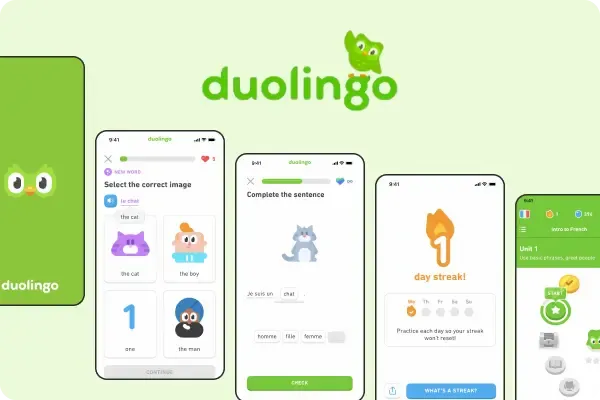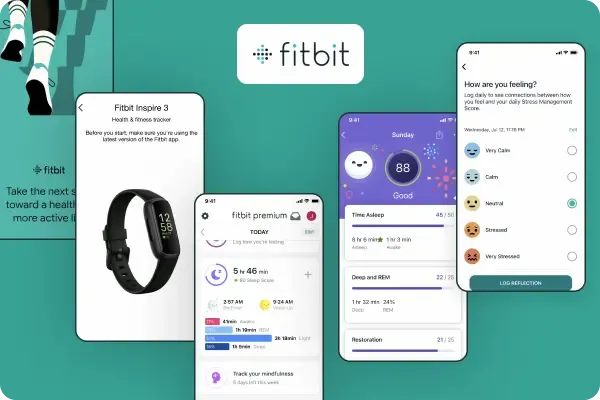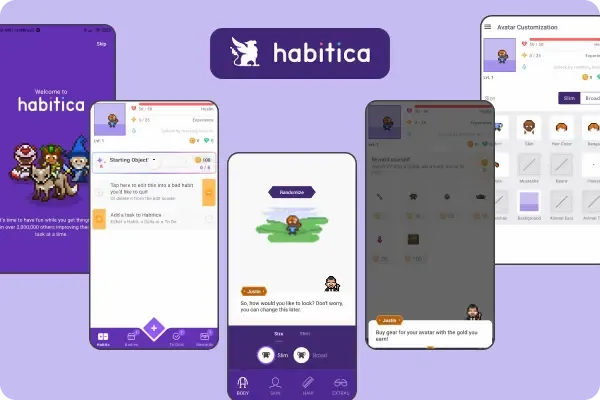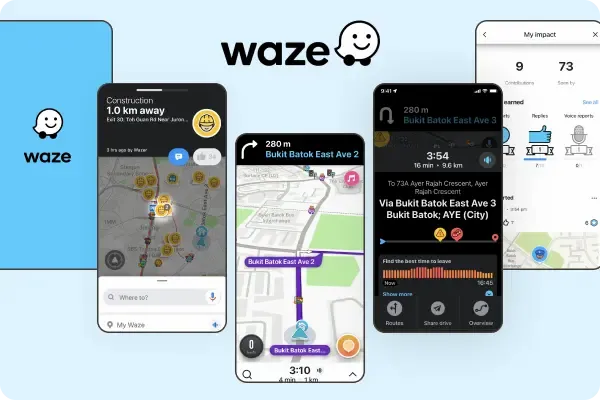Welcome to the world of gamification – a phenomenon that has revolutionized the way we interact with technology.
“Did you know that the global gamification market is projected to reach over $30 billion by 2027 and further expand to USD 89.75 billion by 2031”? From mobile apps to e-learning platforms, gamification has permeated various facets of our digital lives, fundamentally altering how we engage with products and services.
But what exactly is gamification and why has it become such a widely influential factor in modern digital experiences?
At its core, gamification involves integrating game mechanics and elements into non-game contexts, such as apps, websites, and software interfaces. By leveraging principles of play, competition, and reward, gamification seeks to enhance user engagement, motivation, and satisfaction.
In this blog post, we'll delve into the exciting world of gamification in user experience (UX) design.

We'll showcase six standout examples of gamification across different industries and highlight the visionaries driving this innovation. Join us on a journey to understand how gamification is revolutionizing user interaction with technology.
Gamification in UX design
Gamification in UX design involves integrating elements of game design and mechanics into non-game contexts, such as websites, apps, and software interfaces, to enhance user engagement, motivation, and overall experience. Here's a breakdown of what gamification in UX design entails:
- Game Elements: Gamification borrows various elements from games, such as points, badges, leaderboards, challenges, rewards, levels, and progress tracking. These elements add a layer of interactivity and excitement to the user experience, encouraging users to interact with the product or service more engagingly and enjoyably.
- Motivation: One of the primary goals of gamification in UX design is to motivate users to take desired actions or behaviors. By incorporating game mechanics like rewards and feedback loops, designers can incentivize users to complete tasks, explore features, and achieve goals within the product or platform.
- User Engagement: Gamification techniques are effective at capturing and maintaining user attention. By providing clear goals, feedback, and progression pathways, gamified experiences keep users engaged and immersed in the interaction, leading to increased time spent on the platform and higher retention rates.
- Sense of Achievement: Gamification instills a sense of achievement and accomplishment in users as they progress through challenges, earn rewards, and reach milestones. This sense of progress and achievement enhances user satisfaction and encourages continued engagement with the product or service.
- Social Interaction: Many gamified experiences incorporate social elements, such as leaderboards, social sharing, and collaborative challenges, to foster a sense of community and competition among users. Social interaction adds another layer of enjoyment and motivation to the user experience, as users can compare their progress with others and engage in friendly competition.
- Feedback and Progress Tracking: Gamification provides immediate feedback to users, informing them of their progress, achievements, and areas for improvement. Progress tracking mechanisms help users visualize their journey and understand how their actions contribute to their overall success, motivating them to continue engaging with the product or service.
- Emotional Engagement: Effective gamification taps into users' emotions, evoking feelings of joy, excitement, and satisfaction through engaging storytelling, immersive experiences, and personalized interactions. Emotional engagement creates memorable experiences that leave a lasting impression on users and encourage them to return to the platform.

Overall, gamification in UX design is a powerful strategy for creating engaging, motivating, and memorable user experiences that drive user behavior and contribute to the overall success of a product or service. By understanding the principles of game design and psychology, designers can leverage gamification to enhance user engagement and satisfaction across various digital platforms.
6 Best Examples of gamification in UX apps across various industries:
- Duolingo: Duolingo is a language-learning app that incorporates gamification elements to make the learning process more engaging and enjoyable. Users earn points and virtual rewards for completing lessons, practicing regularly, and achieving language proficiency milestones. The app also uses a leveling system to track users' progress and unlock new challenges as they advance.
- Nike Run Club: Nike Run Club is a fitness app that gamifies running and encourages users to set and achieve personal fitness goals. The app offers challenges, achievements, and virtual badges for completing runs, reaching distance milestones, and participating in community events. Users can also compete with friends on leaderboards and share their achievements on social media.
- Fitbit: Fitbit is a health and fitness app that gamifies physical activity tracking and encourages users to stay active throughout the day. Users earn badges and rewards for reaching daily step goals, achieving active minutes targets, and maintaining consistent exercise habits. The app also offers challenges, competitions, and social features to motivate users and foster a sense of community.
- Habitica: Habitica is a productivity app that gamifies task management and habit-building to help users improve their productivity and well-being. Users create characters and go on adventures by completing everyday tasks and building healthy habits. As users progress, they earn experience points, level up their characters, and unlock new abilities and rewards.
- Lifesum: Lifesum is a nutrition and meal-planning app that uses gamification to encourage users to make healthier eating choices. The app offers personalized meal plans, food tracking, and water intake reminders. Users earn rewards and achievements for meeting nutrition goals, trying new recipes, and making sustainable lifestyle changes.
- Waze: Waze is a navigation app that gamifies driving by allowing users to earn points and virtual rewards for contributing to the community. Users can report road hazards, traffic jams, and police checkpoints, which helps other drivers navigate more efficiently. The app also features a social leaderboard that ranks users based on their contributions to the community.






These 6 examples demonstrate how gamification can be effectively integrated into UX apps to enhance user engagement, motivation, and overall experience across various domains, including language learning, fitness tracking, productivity, nutrition, and navigation.
Prominent Figures in Gamification:
Let's take a closer look at some of the key figures who have left their mark on the world of gamification:
- Jesse Schell: Known for his thought-provoking presentations and innovative ideas, Jesse Schell has been a driving force behind the gamification movement. As the author of "The Art of Game Design: A Book of Lenses," Schell has provided invaluable insights into the principles of game design and how they can be applied to enhance user experiences.
- Gabe Zichermann: With his influential books and engaging talks, Gabe Zichermann has been instrumental in popularizing gamification as a strategy for driving user engagement and behavior change. Zichermann's work has helped businesses understand the power of game mechanics in motivating and incentivizing users.
- Jane McGonigal: A leading advocate for the positive impact of games, Jane McGonigal has championed the idea of using gamification to solve real-world problems and promote social change. Through her TED talks and books like "Reality Is Broken," McGonigal has inspired millions to harness the power of play for personal and societal transformation.
- Yu-kai Chou: As the creator of the Octalysis framework, Yu-kai Chou has introduced a systematic approach to understanding human motivation and behavior in gamified experiences. Chou's insights have helped designers and businesses craft more engaging and effective gamification strategies.
Each of these figures has contributed unique perspectives and frameworks that have shaped the evolution of gamification in UX design. From Schell's visionary concepts to McGonigal's advocacy for the transformative potential of games, their collective contributions have propelled the field forward and continue to inspire innovation and creativity.
Conclusion: Let's Level Up with Gamification!
As we wrap up our journey through the world of gamification in UX design, it's clear that this innovative approach has changed the game – quite literally! By adding a touch of fun and excitement to everyday tasks, gamification has transformed how we engage with technology.
From earning points on language-learning apps to competing for the top spot on fitness leaderboards, gamification keeps us motivated and entertained every step of the way. It taps into our natural desire for challenge and reward, making even the most mundane activities feel like an adventure.
But the best part? The journey is just beginning! With endless possibilities and new technologies on the horizon, gamification is set to level up even further. So whether you're a designer, developer, or simply someone looking to make life a little more enjoyable, let's continue exploring the world of gamification together.
Who knows? The next big gamified experience could be just around the corner – and you might be the one to create it! So let's keep gaming, keep learning, and keep pushing the boundaries of what's possible with gamification in UX design.
Frequently Asked Questions
Question 1: What challenges arise during the implementation of gamification in UX design?
Answer 1: Implementing gamification in UX design presents challenges such as balancing fun with usability, catering to diverse user motivations, avoiding over-gamification, maintaining long-term engagement, accurately measuring success, aligning with user goals, managing development costs and complexity, and being mindful of cultural sensitivities.

